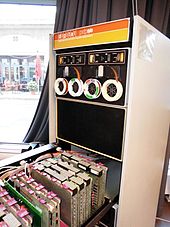1965
| ||

DEC PDP-8
|  | Digital Equipment Corp. introduced the PDP-8, the first commercially successful minicomputer. The PDP-8 sold for $18,000, one-fifth the price of a small IBM 360 mainframe. The speed, small size, and reasonable cost enabled the PDP-8 to go into thousands of manufacturing plants, small businesses, and scientific laboratories. |

A PDP-8 on display at the Smithsonian's National Museum of American History in Washington, D.C.. This example is from the first generation of PDP-8s, built with discrete transistors and later known as the Straight 8.

An open PDP-8/E with its logic modules behind the front panel and two DECtape drives at the top
The earliest PDP-8 model (informally known as a "Straight-8") used diode-transistor logic, packaged on flip chip cards, and was about the size of a small household refrigerator.[5]
This was followed by the PDP-8/S, available in desktop and rack-mount models. By using a one-bit serial ALU implementation, the PDP-8/S was smaller, less expensive, but vastly slower than the original PDP-8. The only mass storage peripheral available for the PDP-8/S was the DF32 disk.
Later systems (the PDP-8/I and /L, the PDP-8/E, /F, and /M, and the PDP-8/A) returned to a faster, fully parallel implementation but used much less-expensive TTL MSI logic. Most surviving PDP-8s are from this era. The PDP-8/E is common, and well-regarded because so many types of I/O devices were available for it. It was often configured as a general-purpose computer.
///
Books
An engineering textbook popular in the 1980s, The Art of Digital Design by David Winkel and Franklin Prosser, contains an example problem spanning several chapters in which the authors demonstrate the process of designing a computer that is compatible with the PDP-8/I. The function of every component is explained. Although it is not a production design, the exercise provides a detailed description of the computer's operation.///
http://en.wikipedia.org/wiki/PDP-8
No comments:
Post a Comment